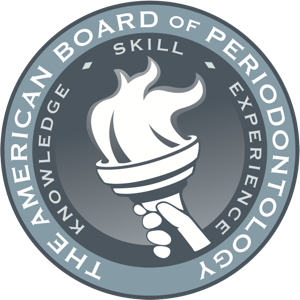
Common Frequently Asked Questions
What is a periodontist?
A periodontist is a dental specialist. Just as orthodontists and oral surgeons are dental specialists, a periodontist is a dentist with three additional years of training in periodontics.
The word periodontist comes from two Greek words peri and odont. Peri means around, like in the words periphery and perimeter. Odont means tooth. As a periodontist, I treat the areas around the tooth.
These areas include the bone, gum, ligament and cementum.
The bone is the jaw bone, which is essentially like any other bone in your body.
The gum tissue is also called the gingiva. It’s the pink tissue that surrounds your teeth.
The ligament, which connects the tooth to the bone, is also known as the periodontal ligament or PDL. This ligament is similar in make-up to any ligament, like the ones in your fingers or your toes. In actuality, the tooth to bone connection is a joint and it has a ligament.
The cementum is a coating around the root of your tooth. You probably know that enamel is the bright white part of the tooth you see when you smile; it’s also called the crown of the tooth. The enamel covers the inner part of the tooth that is exposed in your mouth. The cementum covers the inner part of the tooth that sits below your gum line. This is often called the root, so the cementum covers the root of the tooth.
I work with these four structures, treating the bone, gum, ligament and cementum that surround your tooth.
When your bone or tissue is lost I do procedures to re-grow these lost structures, like a soft-tissue graft (often called just a graft). If your whole tooth is lost, including the root, I replace the root with a dental implant.
What is a dental implant?
A dental implant is a tooth-root replacement.
Your teeth are composed of two main parts: the crown and the root. When you smile, what you see are the crowns of your teeth. Your natural crown is made up of enamel and is typically very white. When necessary, your dentist may make a replacement crown for you which is usually made out of a white-colored ceramic material, although it can be made out of other materials like gold.
If your tooth is more damaged, it becomes necessary to remove your entire tooth, root and all. This is my job: I remove the tooth and replace the root with a dental implant for you. The dental implant is typically made out of metal titanium. (Titanium is a commonly used material in medicine. Your body acts as if the titanium root is part of you, which is why most hip and knee replacements, as well as many of the screws and plates used in orthopedics, are titanium.) Your new titanium root is placed within your jawbone and after a healing period your dentist makes you a new crown for your implant. When your tooth is replaced with a dental implant, it is made up of two parts just like your tooth: a root and a crown.
What is a gum graft?
A gum (gingival) graft is a way of replacing your lost gum tissue.
Your dentist or I may refer to your lost gingival tissue as recession. In medicine, a graft is another word for transplant. A gingival graft is a type of transplant. When I perform a gingival graft I take a piece of tissue from one place and transplant it into another place, typically around the roots of your teeth or your dental implant.
There are several ways to obtain the tissue for the gingival graft. One, which I rarely recommend, is to remove the piece of tissue to be grafted from the roof of your mouth. Although techniques vary, the procedure will result in significantly more pain and a much higher chance of bleeding post-grafting than if more modern techniques had been used. Although there are still occasions where I will take the grafted tissue from the roof of your mouth, mostly because you have chosen that option, I typically use a donated tissue product. With a donated tissue product, I do not take the tissue from the roof of your mouth.
Using donated tissue benefits you in two ways: it eliminates the pain associated with the tissue removal from your palate; and it allows you to have as much grafting as you need or want at a single visit. When I use the roof of your mouth, I am sometimes limited to the amount of tissue I can obtain. When I use donated tissue, I essentially have an unlimited supply of tissue.
Donated tissue comes from an organ donor. The donor is tested for all currently known diseases; other lifestyle items are taken into account. Once tissue is procured, it is sterilized. Fewer than two in one-hundred donors end up being used by the tissue bank where I obtain my tissue. The tissue I use is safe and effective for treating your recession.
Why do I need a gum graft?
You typically need a gum graft because of recession. Recession is the loss of gum tissue around your teeth.
Recession can cause your teeth to appear long or unattractive. Recession can also lead to tooth sensitivity, an increase in cavities, or even the need to remove your teeth.
When I perform a gum graft for you, I can often eliminate all your recession in one treatment. If I can’t eliminate all your recession, I usually can eliminate most of it and leave your gum tissue less likely to recede in the future.
If have further questions or we didn’t answer your question above then feel free to contact us here. We look forward to hearing from you.
Please fill out the form below to request an appointment or call us at 781-812-0740.
Get your free LANAP® treatment guide:
Get your free LANAP® treatment guide:
Here you go! Just click the download link below to download your free LANAP® Information Pack.

